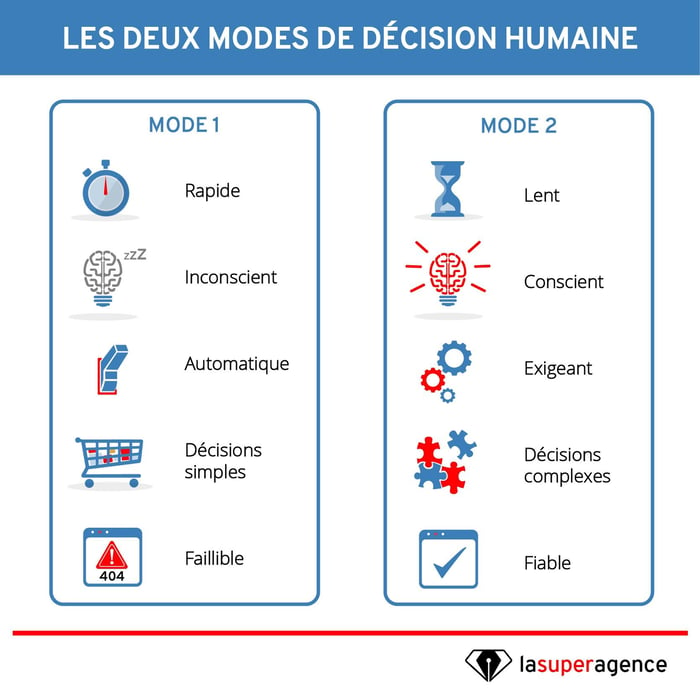Did you know that our brains operate in two very distinct modes when it comes to making a decision?
Psychologist and economist Daniel Kahneman, in his book "Thinking, Fast and Slow” describes a quite singular cognitive process: depending on how much time you have, you don't think at all in the same way.
What implications does this have for recruiting ?
The researcher's central thesis is that our minds use two natural processes for decision making:
- The first or Mode 1 is quick and allows us to choose instinctively - either because emotion dictates it (" what is your favorite color? "), or because learning has made it automatic (" how much is 2 times 2? ")
- The second or Mode 2 is much more slow, and draws on quite different resources, introducing notions of internal conflict, reasoned evaluation, and complex calculations (" how to raise my child? " or " should I buy a house rather than pay rent? ")

Slow Recruitment uses the second mode of decision
Rather than clashing, these two modes work in tandem, each serving a very specific purpose to help humans in their daily lives.
Modern recruiting is no exception to this dual modality. There is indeed a fast way of recruiting, one whose objective is to meet, in a very short time, the hiring requirement, and a slow way, the Slow Recruiting or Slow Recrutement, which places the intimate knowledge of the candidate and the quality of the recruitment before the requirement of speed.
How can these two approaches coexist?
Rapid recruitment, the default mode!
It can be clearly stated that the digital transformation of our societies has led to a considerable acceleration in our decision making.
With a simple gesture you can order from a machine, with a simple click you can buy furniture online.
The Kudoz for example, takes a Tinder-like approach to recruiting - which we're fans of at Super Agency. It connects candidates and employers at the speed of a "Swipe right." Effective!
It has become very (too?) easy for a recruiter to post a job offer on a dozen job boards, potentially reaching thousands of people.
These same people will be able to apply at the click of a button, sending automatically a resume and cover letter while chatting, for example, with friends in front of an episode of Black Mirror season 4.
Bref of fast and effortless recruitment.
But is this how recruitment should be, and more importantly: does it work?
Surely yes!
"Speed is key" as Jacksepticeye says and the " online losses " as we say at EDF, to refer to the energy inevitably lost from the grid, are ultimately an acceptable cost when compared to the productivity gains that these solutions bring.

Speed is key in recruitment?
Slow Recruiting or "Slow Recruiting": a different focus
Let's keep in mind that there is a way of thinking that privileges the laziness, or rather, the patience.
Is recruitment an act similar to an impulse buy or a lengthy decision process?
The truth is...no one knows!
If a great opportunity comes along and you don't have much time to decide, or risk having it slip away under your nose, you may be able to accept a position within hours. This is especially true if you are actively searching.
But you can also discuss it around you, with your relatives, your friends, who will tell you that such a decision deserves reflection and that it may be better to take the risk of losing it rather than committing yourself to something as crucial as your professional life!
This is prevalent among passive candidates, who are often the ones you want to attract to penurial occupations.
As a recruiter, you probably need to " fill " vacancies quickly - but you know that, for others, it won't work.
The problem is that the latter will happen more when you have to fill strategic positions (C-level, developers, sales, etc.).
For these profiles, there is really no " position to fill ", it's all about finding people of remarkable quality, who you sorely need, but haven't yet imagined joining you.
These women and men could eventually consider your business worthwhile, provided they have enough information.
As the "fast" approach is unlikely to work with these candidates, why not slow down and remind yourself that, in the end, it is the turtle who carried away in La Fontaine's fable?
A Slow Recruitment does not mean a painful recruitment process
Insofar as the term Slow Recruitment is not (yet) necessarily well understood, let us agree on one thing:it is not a question of putting sticks in the wheels of the candidate, by asking him to complete an endless questionnaire, in order to stand out from the crowd the most motivated people.
This logic was widely shared by recruiters, especially in the early 2000s. Unfortunately, it has not yet disappeared.
Let's put it bluntly, and even shout it: NO! This near-malicious approach to recruiting as an obstacle course is largely unproductive and will harm your employer brand .
Inbound Recruiting, an offshoot of Slow Recruitment
In a article de Sophie Girardeau pour le site Monster, it is explained that the Inbound Recruitingis one way to go towards Slow Recruitment - from our point of view, the most effective.
Rather than trying to constantly accelerate to meet the needs of recruiters , the idea is to take a little time to meet the needs of the candidate (passive in particular) .
Here is what the candidate might say: " Wait a second, why a qualified and desired profile like the mine should be decided quickly , while I have 10 other headhunters who ask me. Especially since I already have a job! ".
In addition, in an excellent article published recently in the JDN , Christelle Pradier, from Sopra Steria, reminds that the new generation arriving on the job market - the famous millenials - also seeks the establishment of a relationship of trust and authenticity , which is difficult to build at full speed.
You will have to activate mode 2 of his brain!
How to switch to Slow Recruitment?
Maybe it's time to look at talent recruitment no longer as a tactic, but as a strategy.
What's the difference?
A tactic is the way to address an immediate problem, typical of Mode 1.
A strategy will ask you to think of a less obvious solution but may -be more effective in the long term.
Inbound Recruiting appears to be a suitable solution to apprehend recruitment on a strategic basis. It comes in 3 stages:
- The awareness : the content produced and disseminated on a career site activates a first level of reflection where the candidate realizes that your employer brand speaks on subjects that interest him .
- The consideration : the candidate has subscribed to your publications and continues to receive relevant information thanks to which he effectively considers - in the more or less near future - that your company and the positions that you suggest may suit him.
- The decision : sufficiently informed, the candidate will gladly respond to your call offering him a job interview.
The decision process will have been long if we consider it at the level of a single individual, but your recruitment is considerably accelerated as long as you have a talent pool that you can continuously tap into.
In the end, being " slow " will have saved you time !







